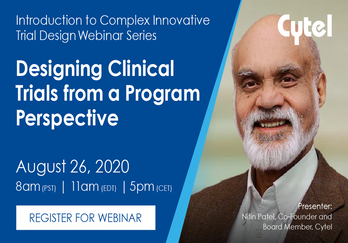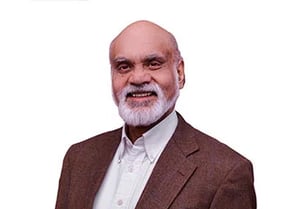Nitin Patel on Designing Clinical Trials from a Program Perspective

It is important to take a strategic approach to clinical development in order to minimize the potential for Phase 3 attrition. In our next webinar from the ‘Introduction to Complex Innovative Trial Design’ webinar series, Nitin Patel, co-founder of Cytel, will provide an overview of the concepts of program optimization. As a case study, we will describe a Phase 2 trial design based on program-level optimization. We utilize a hybrid Bayesian-frequentist framework to evaluate the impact of Phase 2 design choices on the probability of Phase 3 success, clinical utility, time to market, trial costs and expected net present value (ENPV) of the product. These factors include Phase 2 sample size, dose selection and go-no go decision rules for Phase 3, and Phase 3 sample size.
Click the button to register for the webinar on August 26, 2020.
In this blog, we talk to Nitin about his journey since co-founding Cytel; and gain insights on program optimization, the challenges for both big and small pharmaceutical/biotech companies, and how to go about the planning process.
You are a distinguished management scientist in the industry and the founder of Cytel. How has this journey been for you? What is your favorite professional milestone or memory?
It has been a long journey and not something that I envisioned from the start. Cyrus and I became friends when we were doctoral students at the Operations Research Center at MIT. We worked together on solving some problems in computational statistics that would be of use in analyzing small and imbalanced data sets where traditional large sample methods were not reliable. Our research collaboration continued for several years and we published a few papers that were well-received. A number of statisticians urged Cyrus to develop an industrial strength software product based on our work. They suggested applying for a Small Business Innovation Research Grant and offered to write letters of support. This led Cyrus to ask me if I was willing to move to Cambridge to start a company with him. My family and I moved to the US in 1987 and that is when Cytel’s foundation was laid. Pralay Senchaudhuri and Yogesh Gajjar, my colleagues from the Indian Institute of Management, Ahmedabad, also agreed to relocate to Cambridge to join our tiny startup.
I think my most memorable professional milestone was in 1985 when I was awarded the Vikram Sarabhai Medal for Research in Systems Analysis. It gave me a deep sense of confirmation for what I had set out to do in my professional career. Vikram Sarabhai was an inspiring figure for me. He played a major role in setting up of the Indian Institute of Management, Ahmedabad, where I worked for several years. He was the founder of the Indian Space Research Organisation and visited MIT on several occasions when I was a graduate student there. He pioneered in applying quantitative methods to decision making in India when he started the Operations Research Group in Baroda. All of this, put together, gave me confidence in the value of a systems approach using computer based mathematical models to support decision-making in science, industry and government.
How is formulating a program-wide strategy for trial design helpful? Can you tell us about its background/history?
The basic idea of program level decision making is to recognize that each clinical trial is part of a larger program for drug discovery. My experience with developing statistical models with a program perspective began with a PhRMA research group on dose finding studies. Subsequently the DIA set up a working group of professionals from industry, academia and research centers with Dr. Carl-Fredrik Burman as chair to research program level modelling of clinical trials. The focus of the team was on late stage trials, mainly Phase 2 and Phase 3 trials. Phase 2 trials aim to establish proof-of-concept and to select the best dose for Phase 3. If the dose is too high it can cause side effects and toxicity, and if it is too low it can have no effect at all.
There is generally a tendency to go too quickly into Phase 3 from Phase 2. We need to be mindful of the fact that Phase 3 studies are extremely expensive. So, our team focused primarily on how to model Phase 2 and Phase 3 trials as components in a program to gather enough information in Phase 2 to make better decisions about launching and designing confirmatory Phase 3 trials.
From a management perspective, who needs to be involved in the planning phase and how do you recommend driving such an enterprise?
Putting together cross functional teams is the key. You need experts from different areas who can communicate and work together as an integrated team. It is important to have C-level support, especially from the CMO and the CFO for this activity. There is a lot of uncertainty that surrounds clinical trials and we often do not know what the right statistical models will best support our vision. So, you need a diverse group where some persons have a broad understanding of clinical research and statistical models while others contribute an understanding of the commercial, regulatory, trial execution and medical practice side. Drug development is a complex and expensive process, so you need to use your resources well and understand how best to allocate them between Phase 2 trials and Phase 3 trials. Phase 3 trials cost tens of millions of dollars and fail on average 40% of the time.
How does one combine trial design with commercial value?
We need an approach that explicitly addresses the value proposition during the clinical development process by incorporating research and development, marketing, commercial, and medical practice perspectives. A clinical trial simulation tool is necessary to compare multiple development options with respect to the expected value of the product, which clearly depends not only on the quality of the product itself but also on the quality of the development program.
What are the challenges in implementing these trial designs? Does it differ for small versus big pharmaceutical companies?
Big companies have statisticians that are well versed in sophisticated methods to design individual trials. A major challenge is to have them work in cross-functional teams that include decision analysts from finance departments and marketing and trial implementation experts. Sometimes there are different teams of statisticians that work on Phase 2 designs and Phase 3 designs that can lead to difficulties in gaining a program perspective on trial design.
Small companies often do not have resources to perform program level simulations. They rely on standard methods to design Phase 1 and Phase 2 trials that are primarily concerned with showing statistical significance. This is because they expect to do only early studies such as Phase 1 and Phase 2 Proof-of-concept trials. They sell rights to further development or partner with big pharma companies to conduct late stage trials and marketing. However, they too would benefit from modeling downstream value realization of their drugs in negotiations with big companies. Otherwise, they may end up giving up too much of the value of their drugs to big companies. Program level models can also be useful to small companies to raise additional venture capital and private equity funding to carry drugs further in development to secure better terms from big companies.
Can you share a memorable success story?
A memorable success story is the design of an adaptive Phase 3 trial we did for a client. By taking into account commercial downstream consequences in the adaptive trial design, our client was able to negotiate an agreement with an investment company, that enabled them to retain much of the value of the drug if the trial showed significance at an interim look. If they needed to increase the sample size after the interim look to show statistical significance, they agreed to share the upside rewards from a successful trial in exchange for an investment that covered the increased costs of the increased sample size.
Did you experience any push back from your peers and colleagues? How did you convince them?
I think introducing a wider view in clinical trial design is an ongoing process, but companies have started to incorporate commercial and social objectives more explicitly into the clinical trial programs. More companies are using models specifically to improve Go-No go decisions to Phase3. What we really need here is a change of mindset since we now have affordable computing infrastructure to do much more simulation work to support better decision-making than we could in the past. We need to develop more case studies to demonstrate how having a program perspective when designing trials can be of great benefit in terms of efficient use of resources as well as achieving better outcomes.
Where can young and early career biostatisticians and management students learn more?
A book that provides a very good introduction to designing clinical trials from a program perspective is ‘Optimizing the design and investment strategy of Pharmaceutical R&D programs and portfolios, Antonijevic Z (ed.) Springer 2015.
A shorter overview is available in ‘Program and Portfolio Decision-Making’ by Nitin Patel,et.al., Chapter 26 in Bayesian Methods in Pharmaceutical Research’. Lesaffre E, Baio G, and Boulanger B (ed.) pp485-509.
There are also several articles on program level clinical trial design that are referenced in these books.
Webinar details:
Designing Clinical Trials from a Program Perspective
Wednesday, August 26, 11AM EDT
About Nitin Patel
 Over 30 years in the US, Nitin Patel has led development of several innovative statistical software products and worked on collaborative research projects with major pharmaceutical companies. He has served as a member of PhRMA and DIA working groups on adaptive trials contributing in the areas of dose finding trial design, drug supply, adaptive programs and portfolio optimization. In India he worked at Tata Consultancy Services where he was a member of the founding management team in 1966. He joined IIM Ahmedabad as professor in 1975.
Over 30 years in the US, Nitin Patel has led development of several innovative statistical software products and worked on collaborative research projects with major pharmaceutical companies. He has served as a member of PhRMA and DIA working groups on adaptive trials contributing in the areas of dose finding trial design, drug supply, adaptive programs and portfolio optimization. In India he worked at Tata Consultancy Services where he was a member of the founding management team in 1966. He joined IIM Ahmedabad as professor in 1975.
He co-founded Cytel with Cyrus Mehta in 1987 where he is a member of the board and a lead researcher at the Innovation Center. He has Masters degrees in Management and in Computer Science-Electrical Engineering, and a Ph.D. in Operations Research from MIT. He has been a visiting professor at MIT and at Harvard University for over a decade. He is a Fellow of the American Statistical Association and a Fellow of the Computer Society of India. He has served as president of the Operational Research Society of India and as vice president of the International Federation of Operations Research Societies. He has published over 70 professional peer-reviewed papers and book chapters and co-authored a book on data mining that is now in its 3rd edition.


